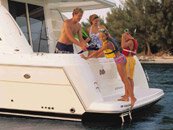When you start sailing, you’ll navigate by looking where you want to go, and going there. Some people spend their whole sailing careers that way. But it’s a good idea to learn at least basic navigation— to be able to read a chart, plot a course and steer accurately by compass. It’s easy to learn, and you don’t need much in the way of math skills. If you take a sailing course, the curriculum will include all the above, and more.
Once you start sailing on your own, you should assemble a kit with essential navigation tools, especially if you’re going to rent boats. Few rentals have anything in the way of navigation equipment other than a compass, and sometimes not even that, so you’d better bring your own. Here’s what you need—it’s all available at any marine store:
- A chart of the area where you’ll be sailing. Buy a waterproof chart in the largest scale you can find: A large-scale chart covers a smaller geographical area, with lots more detail, than a small-scale chart. (The salesperson at the store can help with this.)
- Parallel rules, which is two rulers, hinged together in such a way that they remain parallel when the distance between them is adjusted. Before sailing, use your parallel rules to determine the latitude and longitude of key locations—where you’re sailing from, places you might want to go, etc.—and write them on the chart. Draw lines between key points, too, with the magnetic bearings, in both directions, written on the lines. It’s easier to do this ashore than on the boat; you’ll learn how to do it in your learn-to-sail program.
- A hand-bearing compass, which is a simple compass fitted with a sight. You point it at a lighthouse, landmark, etc., and read the direction—the “bearing”—to that object off the compass. Take bearings of two or more objects, plot them on your chart and where the lines cross is where you are. You won’t be doing this if you carry a GPS (see below), but if your rental boat has no compass, the hand-bearing compass can serve for steering, too.
- A simple handheld GPS. Old salts say you should learn to pilot with chart, parallel rules and dividers (an instrument used for measuring and transferring distances), and that’s true—but on a small boat, with no place to lay out the chart, the wind blowing and the spray flying, the GPS makes a lot more sense. It will tell you where you are, what course you’re sailing and, if you input the latitude/longitude coordinates of a destination (you can do this ashore), how far away it is and in what direction. It works at night and in the fog, too. Carry the GPS in a waterproof case, and bring spare batteries.
- A handheld marine VHF radio. If you get into trouble, the VHF is the fastest way to summon help; the Coast Guard, marine patrol, harbormaster and other authorities all monitor VHF channel 16. You can also receive weather reports and forecasts. Buy a basic waterproof model, and charge the batteries before each sail.
All of the above will fit in a small bag, and weigh less than your lunch. Carrying it will make your sailing trips safer and more fun.
See Also:


